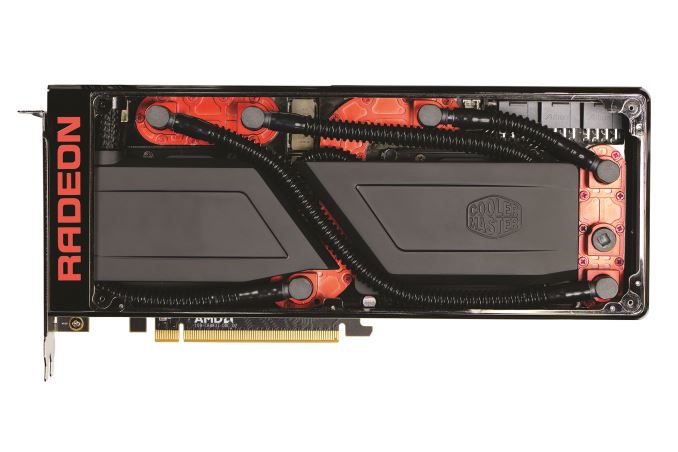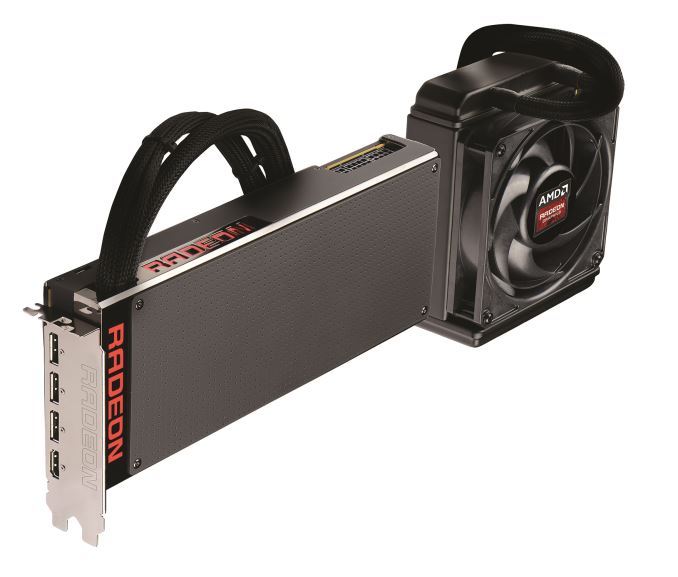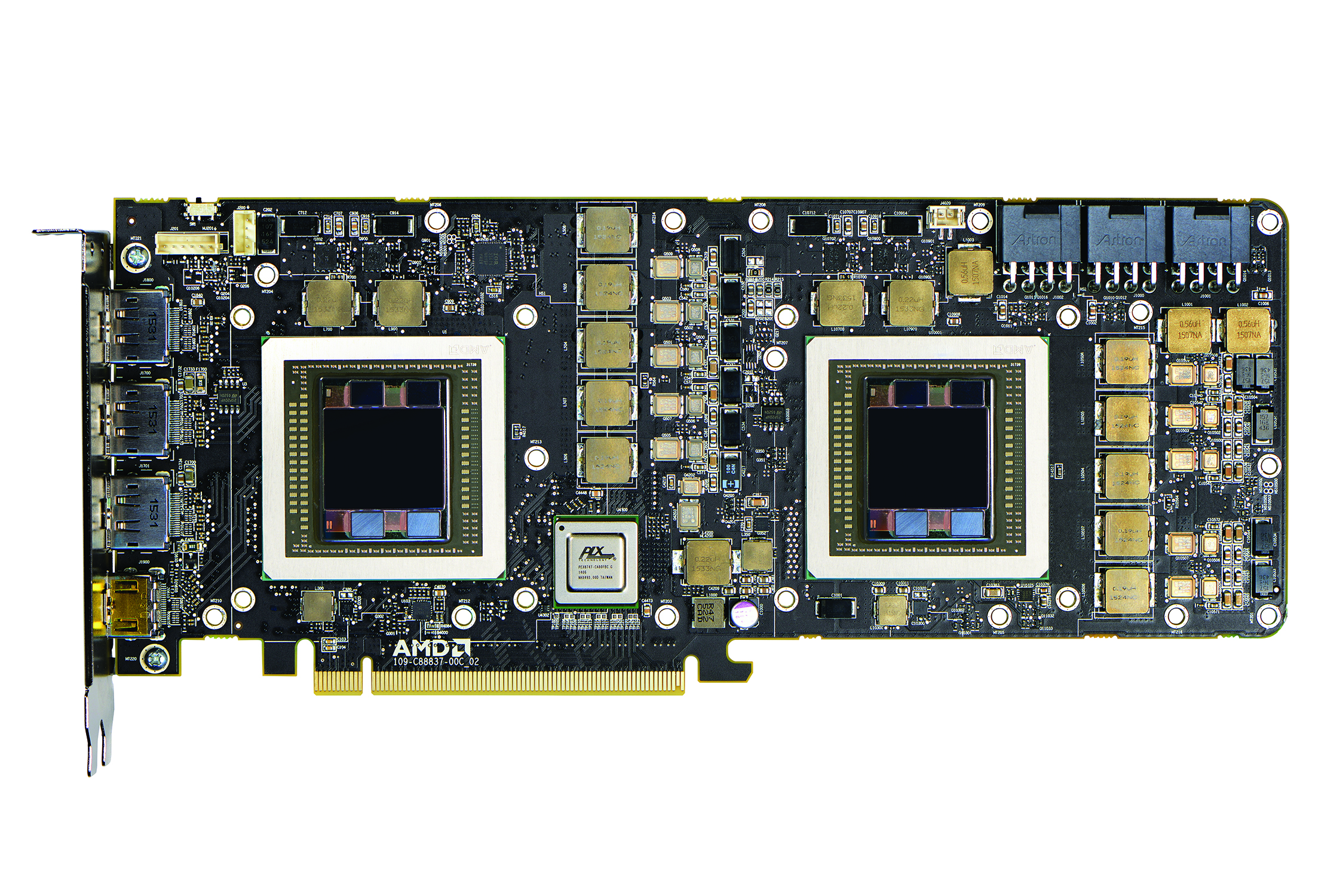AMD Releases Radeon Pro Duo: Dual Fiji, 350W, $1500
by Daniel Williams on April 26, 2016 9:00 AM EST
These recent years we have seen a slow but steady buildup of VR from both technological developments to growing enthusiasm shown by consumers and the industry. Today AMD is releasing the Radeon Pro Duo to the market as their first card targeted at VR developers. This card is not being directly aimed at gamers, despite the capability under the hood, but focuses on official support for professional software. Additionally, multiple initiatives are being both spearheaded and supported by AMD and others to encourage growth in the VR sector.
The AMD Radeon Pro Duo was first announced back in March, with the card is being marketed for VR content creation first and foremost. With this card, AMD is promoting the ability to allocate one GPU per eye while powering VR experiences. This way the case is opened up for performance beyond what any other single card can offer today. Another use case for developers is offloading compute work to the second GPU while the first is used for graphical work which can make for a much smoother experience during demanding a workflow.
Gaming is definitely possible on Radeon Pro Duo and alongside the FirePro drivers for content creators, Radeon drivers will be available. The Pro Duo will not see validation for as many applications as a true FirePro card, but official support will be provided for applications important to gaming content creation such as Autodesk, Maya, and Blackmagic Davinci Resolve.
| AMD GPU Specification Comparison | ||||||
| AMD Radeon Pro Duo | AMD Radeon R9 Fury X | AMD Radeon R9 Fury | AMD Radeon R9 295X2 | |||
| Stream Processors | 2 x 4096 | 4096 | 3584 | 2 x 2816 | ||
| Texture Units | 2 x 256 | 256 | 224 | 2 x 176 | ||
| ROPs | 2 x 64 | 64 | 64 | 2 x 64 | ||
| Boost Clock | 1000MHz | 1050MHz | 1000MHz | 1018MHz | ||
| Memory Clock | 1Gbps HBM | 1Gbps HBM | 1Gbps HBM | 5Gbps GDDR5 | ||
| Memory Bus Width | 2 x 4096-bit | 4096-bit | 4096-bit | 2 x 512-bit | ||
| VRAM | 2 x 4GB | 4GB | 4GB | 2 x 4GB | ||
| FP64 | 1/16 | 1/16 | 1/16 | 1/8 | ||
| TrueAudio | Y | Y | Y | Y | ||
| Transistor Count | 2 x 8.9B | 8.9B | 8.9B | 2 x 6.2B | ||
| Typical Board Power | 350W | 275W | 275W | 500W | ||
| Manufacturing Process | TSMC 28nm | TSMC 28nm | TSMC 28nm | TSMC 28nm | ||
| Architecture | GCN 1.2 | GCN 1.2 | GCN 1.2 | GCN 1.1 | ||
| GPU | Fiji | Fiji | Fiji | Hawaii | ||
| Launch Date | Q2 2016 | 06/24/2015 | 07/14/2015 | 04/21/2014 | ||
| Launch Price | $1499 | $649 | $549 | $1499 | ||
The Radeon Pro Duo is essentially and effectively two Radeon R9 Nanos together on a single PCB. At a high level, the Pro Duo should give us up to twice the performance at twice the power consumption (plus a bit extra for PCIe switches). To remove heat, the card comes with a closed loop cooler similar to that found on AMD’s Radeon R9 Fury X. This cooler, unlike the one found on the R9 295X2, provides a complete liquid cooling solution covering the VRMs on both GPUs along with the GPUs themselves. For reference, the pipes on this one are 540 mm long, and the double-thick radiator with fan comes in at 63 mm
Moving past the cooling solution we get three full sized DisplayPort connectors and one full-size HDMI port. On the side of the card there are three 8-pin PCIe power connectors which will do more than an adequate job of supplying the rated 350W power draw. Note that 350W is the equivalent of dual R9 Nano cards (rated at 175W a piece), and will be clocked similarly. The reactive frequency adjustments to heavily loading, by inference, are likely to be similar but we expect AMD to be using low-power binned parts for their new high-end card.
The Radeon Pro Duo is launching today at $1500, or three times the current price of the R9 Nano. That’s a $500 price premium to combine two cards into one. Even with the price, AMD is keen to admit that the Radeon Pro Duo is now the single fastest graphics card on the market since the competition doesn’t offer a similar product at this time. From our perspective at AnandTech, we still advise that users are better off investing in a single powerful GPU first, and only scaling out into SLI/CF when requirements for extreme performance are such that a single GPU solution cannot provide. With VR, it stands a good chance at pushing gaming machines harder than anything we’ve seen so far, especially when trying to maintain a smooth and low latency experience. It all depends on the workflow and subsequent frame rendering methods used.
Alongside all of this news and information is renewed attention for several initiatives AMD is taking part in. AMD has placed the Radeon Pro Duo as the first card in their AMD VR Ready Creator Line. The goal being that the Pro Duo, coupled with Liquid VR, will create a powerful and capable platform to develop future VR experiences. The AMD VR Ready Creator Line is also the platform of choice for Crytek’s VR First initiative, which intends to foster growth in the VR industry by supporting developers by powering virtual reality labs in colleges and universities around the world.
We are approaching a crossroads between the outgoing GPU generation and the upcoming cards coming out later this year. The Radeon Pro Duo is part of an outgoing generation but aims to provide a competent platform for VR content creation following known architecture guidelines. Along with the new hardware released today, there are many initiatives in motion that aim to encourage growth in VR, and new hardware will continue to be an important tool for creating innovative experiences moving forward.
We have already seen Tmall post up an early listing for an XFX variant of the Pro Duo, and retailers should be showing other OEMs variants today as well. At current, AMD's base design is expected to be the sole variant of the Pro Duo.
Source: AMD


























63 Comments
View All Comments
haukionkannel - Tuesday, April 26, 2016 - link
Most propably near the launch of Vega... This is expensive card to produce, so early 2017 there may be price cut. Most propably not.blzd - Tuesday, April 26, 2016 - link
Dual GPU cards have always come with a price premium. Just not usually at this level.Death666Angel - Tuesday, April 26, 2016 - link
Their prices fell, really? The times I checked them (for potentially driving a VR HMD), they were all above 900€, about 3 times the cost of a R9 290. Sure, they probably dropped in price compared to their MSRP, but then again, everything does.webdoctors - Tuesday, April 26, 2016 - link
Man, what monkeys are running this division? Are they actually going to recoup the cost of this board? The volume already for these cards is so low, when you have to engineer this SLI frankenstein and than do the verif and QA checks. How likely are you going to recoup costs when there's going to be a GPU refresh in months so the window for this card to sell is tiny.Death666Angel - Tuesday, April 26, 2016 - link
"How likely are you going to recoup costs when there's going to be a GPU refresh in months so the window for this card to sell is tiny."Dual GPU cards have usually ended up being release 6 months to a year after the initial release. So even if we get new GPUs in the coming months, a new dual GPU card won't happen for another good chunk of time.
Beany2013 - Tuesday, April 26, 2016 - link
In the professional world, time is money.In some markets, the time is a *lot* of money.
The cost of these cards could be saved just by knocking a few hours off a finished project in some areas, if it means you can move onto the next project sooner - or get the deposit for the next project sooner, meaning you can expand your business with the extra cashflow, etc.
Whether it'll be replaced in six months time with something just as quick using less power is irrelevant; whether it can give me a competitive edge *now* so I can take that upcoming contract from the competition is what matters in most of the professional hardware purchasing world.
webdoctors - Tuesday, April 26, 2016 - link
Beany2013, I agree with you completely. Folks will buy it, but will it be enough to break even?Assuming there's 100 VR companies (I'm assuming that's a lot of VR companies?), and each company buys 20 cards, that's 2000 cards. That's $3M. If these have a 70% profit margin, than they make $2M. That'll pay for 10-15 engineers depending on where they're based...I'm guessing this chip took 6 months time for 30-50 engineers. Or cost of 15-25 engineers...
So on the surface it seems this is a loss leader? Maybe to get devs hooked on using AMD products for VR development?
prtskg - Wednesday, April 27, 2016 - link
You have forgotten that there is a firepro version of this card too which has already won a contract in chime telescope. I wouldn't be surprised if the investment in dual fury cards would be recouped faster than other fury cards.webdoctors - Friday, May 6, 2016 - link
With the release of the 1080 card at the end of the month for half the price or less of this card, this card will be obsolete before launch.onbquo - Tuesday, April 26, 2016 - link
oh boy! Have you seen that 1 TB/s memory bandwidth? I think that's a first..